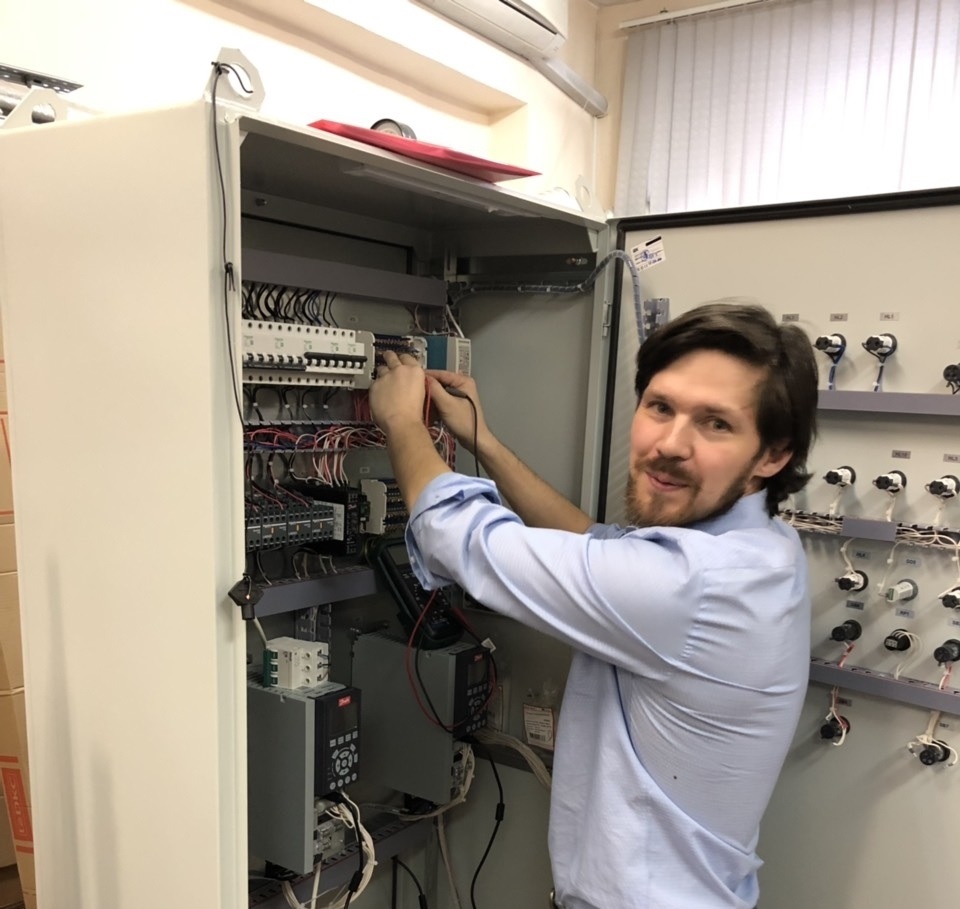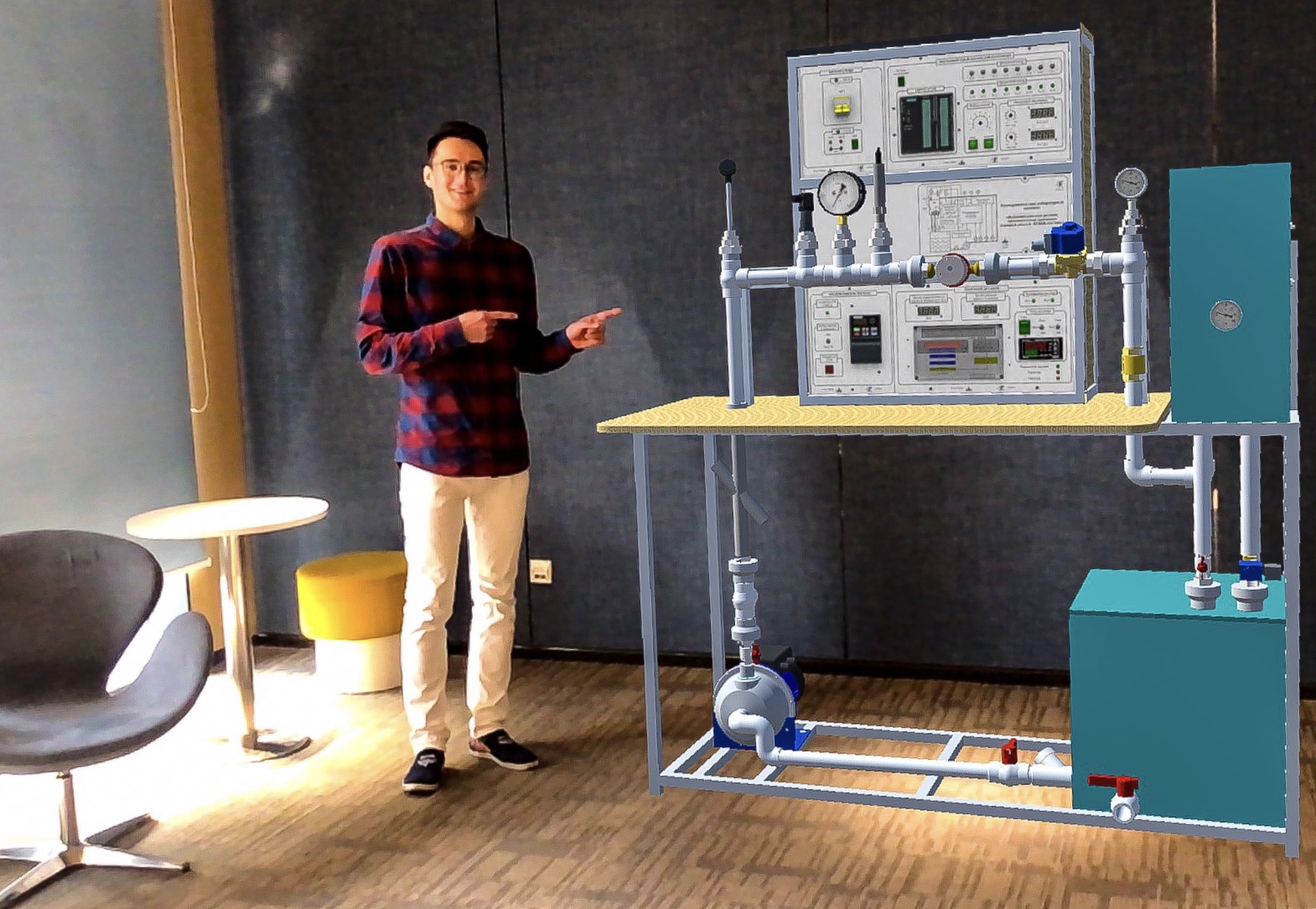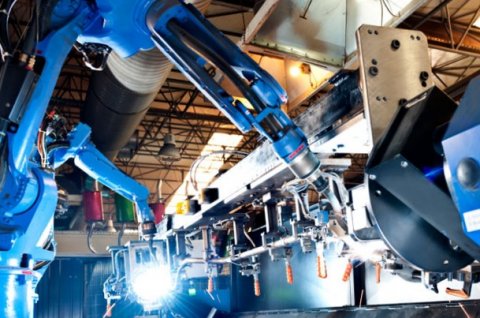The fourth industrial revolution, when digital production unites industry and digital technologies, has become a reality. People manage production with the help of digital technologies and the Internet, so traditional education techniques are already insufficient. Within SUSU’s project-based learning, the Department of Automated Electric Drive of the Faculty of Energy and Power Engineering of the Institute of Engineering and Technology trains students in technologies of managing smart electric drives at modern factories.
We spoke with the supervisors of the project on Smart Electric Drive with the Internet of Things and Augmented Reality, associate professors of the Department of Automated Electric Drive, Candidates of Sciences (Engineering), Aleksandr Nesterov and Andrey Kachalov about the evolution of the concept of an “electric drive” in modern electrical engineering, the role of the new generation of electric drives in the development of Industry 4.0, the application of the new generation of smart electric drives in modern factories, and the innovations of SUSU research in this field.
– How was the idea for this project born?
A.N.: The Smart Electric Drive with the Internet of Things and Augmented Reality project is the logical next step of research being held in our Department. We have been working on the use of augmented reality with training benches for a few years now. Within a grant at SUSU for this field of research, together the Bachelor’s and Master’s students of the Department of Automated Electric Drive we have developed a prototype of a work bench with augmented reality. One of the Bachelor’s students of the first project, Pavel Vanin, joined the project-based learning, and the second one, Ivan Kholodilin, is completing his post graduate studies in a Chinese partner-university. The project that our student is working on at Beijing Institute of Technology is related to machine vision (theory and methods of creating machines able to detect, track, and classify objects – Ed. Note). The programme lasts for four years; our graduate highly praises Beijing Institute of Technology, noting their great scientific potential and commitment to research.
Within project-based learning, the subject of our research is an industrial object equipped with a new-generation electric drive (this is what we call a smart electric drive), adding to it augmented reality technology and the Industrial Internet of Things.
– The project has two supervisors. What is the role of each of you?
A.K.: Our project is a global project. The term “Smart Electric Drive with the Internet of Things and Augmented Reality” includes a full complex or system of technologies and engineering; one supervisor simply would not be able at this time to fully cover all of these fields with his knowledge.
Aleksandr initially gravitated towards industrial controllers, automation, and information systems; I was always closer to electronics, including power electronics, to real implementation of ideas “in steel”, interaction with electric drives, and traction mechanisms. So, we made the decision to appoint two leaders with different areas of responsibility in the project. This division by field of research is maintained in both the research projects and project-based learning.
.jpg)

Andrey Kachalov Aleksandr Nesterov
– How are Master’s students involved in the project?
– In working on the plan for developing the project, we decided that the key areas of work must be differentiated: the main portion of the research within this project involves four Master’s students, and each of them has a certain area of responsibility. There are two more students involved in the subproject.
The participants of the main project include Master’s students from group П-186 of the IET Faculty of Power and Energy Engineering: Vsevolod Vdovin, Dmitriy Schekolov, Boris Svistunov, and Pavel Vanin.
Vsevolod is working on the subproject with Bachelor’s student Elizaveta Kotelnikova. The topic of their subproject is “Hardware Using Sensors and IoT Gateways to Connect to a Cloud Application”. Dmitriy Schekolov is working on developing hardware and software for the system with simulation on a microcomputer; Boris Svistunov – the mathematic modelling of processes occurring in an asynchronous motor; Pavel Vanin and subproject participants Anton Buller and Ivan Kholodilin are developing an augmented reality interface and cloud-based application.
You can find out more about the developments under this project in the supplement to this interview.
In the future, we are planning on combining all of the developments from the research by Master’s students into one stream. These four streams will merge into a single river, which will serve as the logical successful completion of the project.
A.N.: The students are full of enthusiasm, they are eager to work with the equipment, but in the first stages, before moving to experiments, we need to work on the theoretical basis.
A.K.: You can make a parallel with music school lessons. When a child enrols in music school, s/he first learns musical notation. S/he still is unable to play an instrument. In this period, it’s difficult for him/her to have any success, there’s a lot of confusing theory and no practice. Students can lose enthusiasm this way, and it’s very important to support their interest and the meaning of the lessons at this stage. Right now, you could say that our students are working on “musical notation”. But we know how important it is to move to practical studies at the right time. This is important both for maintaining Master’s students’ interest in the project and for the promotion of the project as a whole.
Experiments in this project will be held both within the Department’s laboratories and at Uctech-Profi. The university has all of the necessary equipment to perform experiments. And in the near future, together with the Master’s students we are planning on beginning one of the key experiments in our project.
– An interdisciplinary approach is very important for project-based learning. Who are you planning on working with at the university?
A.N.: Our Department is named Automated Electric Drive, but electric drives became part of informational systems in factories a long time ago. There are several components in the concept of an “electric drive”: the mechanical part (the electric drive is attached to a mechanism); the power, which is included in the energy system and affects it; and the part related to the enterprise’s information systems.
The concept “smart electric drive”, with which we are working in the project, is more broad than “automated electric drive”, so the project can be considered interdisciplinary, since we need the help of specialists from various fields of science.
In our time, the concept of electric drive is gaining new meaning. In the beginning there was the term “unregulated electric drive”, then “regulated electric drive”, in the next stage, the electric drive became automated, and now it’s become smart.
A.K.: And this is happening right now, in our time!
When we were still studying in university, 10-15 years ago, there was no talk of smart electric drives. Step-by-step we moved towards digital electric drives. And today, before our eyes, powerful microprocessor technologies are appearing, the capabilities of data processing in objects and in cloud databases are broadening. These technologies are closely intertwined with electric drives; it’s becoming part of Industry 4.0.
A.N.: I’d like to note, that the concept of a “smart electric drive” itself did not exist before. In science today, there is the concept of an “automated electric drive”, but there still is no “smart electric drive”.
If you go online or search for these concepts in specialized literature, you’ll find smart drive, but this technology is nearer to automobiles. If you type “Smart electric drive” in the search box, you will be shown smart cars, but none of this has a direct relation to our developments.
If you type in this same term in Russian, you will see similar terms related to the electric drives of stop valves. But there is no exact term “smart electric drive” yet, because it is being formed right now. In our research, we are forming the concept of “smart electric drive” and we are planning on patenting it in the future.
– You can become pioneers in scientific publications and suggest this term to the scientific world?
A.K.: That’s what we’re trying to do!
One of the important conditions of project activity is having publications in Scopus and Web of Science. Are you planning on publishing papers on this project soon?
A.N.: Yes, of course. During the first six months of the project work, each Master’s student prepared materials within their field of research. Now we must generalize and systematize these materials and prepare them for publication. Our Master’s students will be co-authors.
– Where are you planning on publishing them?
A.N.: In the theme-relevant journals indexed in Scopus.
A.K.: Today, our direction of research is among the most important ones, so we believe that material on smart electric drives will be published in TOP-25 journals. We have already published materials on similar topics in the Slovakian journal Communications. This journal is of high quality both in terms of its presentation of the material and in terms of its review process. New publications on our project-based learning within the Smart Electric Drive field will also be sent to this journal.
A.K.: Let’s get back to the interdisciplinary approach… When developing the project, we quite often work with information technologies; we will most likely need the help of programmers, so we are expecting to partner with different institutes and schools at our university.
A.N.: The interdisciplinary approach is important, but we are also trying to teach our students programming skills. For example, when students worked on the training benches with augmented reality, I gave them exercises for which they needed to master Unity and Solidworks to work on the informational benches with augmented reality to develop models (Unity is a multiplatform environment for the development of computer games; Solidworks is a professional program for industrial project planning and simulation – Ed. note).
Right now, one of our former Master’s students, and today a postgraduate student of our university and, simultaneously, a Master’s student at Beijing Institute of Technology Ivan Kholodilin (advisor – Maksim Dudkin, Faculty of Energy and Power Engineering) is working on all of this on his own. He is able to work in Unity and Vuforia (Vuforia is a plugin for implementing augmented reality – Ed. note) and does not need any help from programmers, since he is a highly qualified specialist in this field.
A.K.: We are working so that our specialists receive an all-round education and gain the necessary skills, even more than what they need according to the standard, and become truly highly qualified specialists! This is one of the higher goals of SUSU’s project-based learning.
.jpg)

– How do you work with the main client of this project, Uctech-Profi Educational Equipment Manufacturer?
A.K.: Today, Uctech-Profi Educational Equipment Manufacturer is a leader in the development of laboratory benches in Russia. This business is constantly evolving, moving forward, and introducing new technologies into their range of benches. So they are directly interested in gaining new promising developments and then, through their benches, delivering them to future Bachelor’s students, Master’s students, and so on.
We are planning on actively working with Uctech-Profi in the practical stage of our project, when we need to build and debug our equipment. We will need debugging tools. The Department of Automated Electric Drive has good equipment and a rich material base, but there may be something we don’t have. So, we are really counting on the help of Uctech-Profi Educational Equipment Manufacturer. In addition, we are planning on having the Master’s students complete practical training at Uctech-Profi.
– What fields of industry will use your innovation?
A.K.: Electric drives are the most common object at any enterprise. Modern workshops are heavily automated; they have a huge number of actuators, electric motors, valves, fans, and so on.
These devices can form a complex: if, for example, there are around a thousand electric motors in one rolling mill, it becomes difficult to predict the performance and condition of each of them.
Our main goal within the project is to efficiently diagnose the technical condition and remaining resources of objects with the help of smart electric drives using the Internet of Things and augmented reality and make them more available.
The smart electric drive technology that we are presenting, which is equipped with software and hardware modules for the Industrial Internet of Things and augmented reality, can be of use in large businesses where a big number of electric drives are in use.
In terms of potential partners, we are considering the leading metallurgic businesses in our region: ChelPipe, Mechel, Magnitogorsk Iron & Steel Works. In these businesses, they need specialists in smart electric drives, whom we are training within our project-based learning programme.




